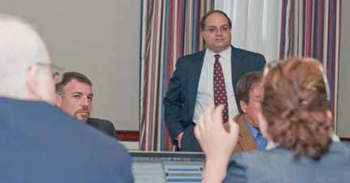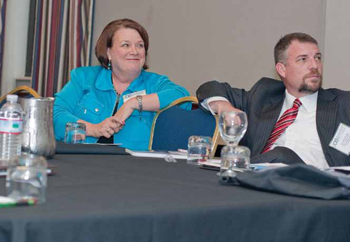The Student

The school day no longer starts at eight and ends at three. Today’s students are around-the-clock learners, requiring individualized lessons, opportunities to create instead of consume, and the freedom to work at their own pace, in their own setting, with 24/7 access to their instructors. Districts should oblige and support this new reality.
[The scenario]
Jerry Crisci,
Director of Technology,
Scarsdale Public
Schools, NY At Tae Kwon Do District, every student has an electronic binder that they use to track their academic progress, host their e-portfolio, and chart their growth. Teachers work in teams, uploading individual and group projects for students to work on, and all projects allow students to demonstrate such 21st-century skills as critical thinking, global awareness, problem solving, environmental literacy, and seamless use of technology. Of course, the projects also allow students to learn the core subjects, but instead of a student taking language arts or algebra, the courses are interdisciplinary and students gain writing, reading, and math skills by working on their projects.
Like any professional, these 21st-century students use technology to get their (school) work done, choosing whichever tools are the most appropriate for the task at hand. They can log on to Tae Kwon Do’s network (either within the school grounds or remotely, at a Starbucks, the town library, or in their kitchen) to pull down any resources they need, communicate with their teachers and peers, and get additional assistance.
[Executive Summary]
From Scarsdale (N.Y.) Public School’s Education for the Future to Calcasieu Parish (La.) Public Schools’ personalized learning and iTEACH programs to the booming online-learning initiative at Los Angeles Unified School District, SchoolCIO Summit attendees are turning their schools into the types of dynamic places that today’s 21st-century students require.
Sheryl Abshire, CTO,
Calcasieu Parish Public
Tools and ideas to transform education. Sign up below.

Schools, LA
Richard Valerga, Chief Information Officer,
Memphis City Schools, TN
Since 2008, Scarsdale teachers have focused not on testing but on creating a love of learning. They’ve helped foster responsible citizenship (online and off) by participating in interdisciplinary teaching about global issues, such as sustainability. All seventh-grade students learn about literacy in information, media, and technology by creating PSAs as part of the Middle School Empathy Project. The Kindergarten Dance Program, K–5 inquiry research initiative, fifthgrade Capstone technology and research project, and grade 12 global-citizenship project all include elements of authentic problem solving, creativity, and critical thinking.
Calcasieu Parish has been an online district for 15 years. E-learning spiked during Hurricane Katrina, when this devastated community had no downtime in learning. Students were scattered throughout the country but could go online and keep up with their classes. The district’s iTEACH model—in which teachers in model classrooms filled with iPads build their own curricula and teach others—is another way that these 21st-century teachers reach students where they live.
And in Los Angeles, more than 22,000 students took an online course last year; 8,000 took more than one online course. The district uses various products to deliver these courses, including Moodle, homegrown offerings, Apex Learning, ALVS, and e2020. The reason for the variety of products is to serve the very different needs of today’s unique students.
What They Said
“We have all the key ingredients in place to transform education in our district— strong teachers and administrators, a visionary school board, and a community that values its schools. The challenge is figuring out what schools will look like in 10 years and determining how we can prepare students to solve complex problems that don’t have easy answers.”
—Jerry Crisci, director of technology, Scarsdale Public Schools, NY
“You have to have a 21st-century staff first. We must retool the profession to deliver 21st-century educators. We’re working with Louisiana State University to change the curriculum and requirements so that teacher candidates learn how to truly integrate technology while in ed school.”
—Sheryl Abshire, chief technology officer, Calcasieu Parish Public Schools, LA
“The current educational paradigm is heavily influenced by the learning experiences we had as students, but we want to look at the new context of the present learning landscape and ask ‘What are we doing to teach our kids how to learn?’ Our Forward Learning plan will move beyond the rote and toward the skills necessary to be successful in our changing world. We will focus on critical thinking, problem solving, collaboration, creativity, written and oral communication, and technology, along with building a solid foundation of general knowledge.”
—Art Fessler, superintendent; Ben Grey, chief information officer, Oak Lawn– Hometown 123, Oak Lawn, IL
Working Group Take- Aways
Questions for Teaching today’s 21st Century Student
• Is there a difference between “critical thinking” and “creative thinking?”
• Is there a difference between “creative thinking” and “creativity?”
• Is artistic creativity the same as creativity in other situations?
• Can creativity be taught?

* SOURCE Jerry Crisci, Scarsdale Public Schools
Find more take-aways from the School CIO summit in the program vault under schoolcio.com (click on “Events”).
[Participants]
Kevin Anderson
Superintendent of Schools
Elmwood Park CUSD 401, IL
Dr. Gary Carnow
Chief Technology Officer
Pasadena Unified School District, CA
Julia Fallon
Technology Integration Program Manager
Office of Superintendent of Public Instruction, WA
Richard Valerga
Chief Information Officer
Memphis City Schools, TN
Sheryl Abshire
CTO
Calcasieu Parish Public Schools, LA
Jerry Crisci
Director of Technology
Scarsdale Public Schools, NY
Art Fessler
Superintendent
Oak Lawn-Hometown 123, IL
Ben Grey
Chief Information Officer
Oak Lawn-Hometown 123, IL
Themistocles Sparangis
Chief Technology Director
Los Angeles Unified School District
